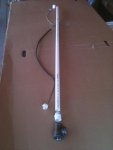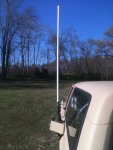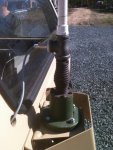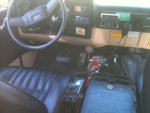-
Steel Soldiers now has a few new forums, read more about it at: New Munitions Forums!
Ham Radio Operators / Steel Soldiers
- Thread starter oifvet
- Start date

More options
Who Replied?bshupe
New member
- 440
- 4
- 0
- Location
- Mount Vernon, WA
I just got my mobile installed in my M1031 today. iCom v-8000 2m with a 5/8 wave larsen fender mounted wip.
Im glad to have alternatives to the handheld and rubber duck now.
I would like to use the mobile as a base station sometimes as well. I have a tall tree in the back and was thinking that a simple ground plane antenna would work. Does anyone have any thoughts on the benefits of putting it in a tree vs. my roof taking into account the risk of climbing the tree and the sizable cost of a coax that long?
Also, anyone have a favorite power supply or docking station for running a 75w mobile in the house?
Thanks!
Im glad to have alternatives to the handheld and rubber duck now.
I would like to use the mobile as a base station sometimes as well. I have a tall tree in the back and was thinking that a simple ground plane antenna would work. Does anyone have any thoughts on the benefits of putting it in a tree vs. my roof taking into account the risk of climbing the tree and the sizable cost of a coax that long?
Also, anyone have a favorite power supply or docking station for running a 75w mobile in the house?
Thanks!
Truckoholic
New member
- 492
- 13
- 0
- Location
- Colorado Springs, CO
I've got an Icom V8000 in my logging truck. Nice radio's. Not sure the risk of climbing all the way up the tree would be worth it, but definitely height is your friend and you will probably see fairly significant difference in signal strength from the top of the tree as opposed to the roof so long as it does not require so long of a coax run, that any benefit in signal strength is lost in the line. Typically you can run coax 100-150 feet without a problem.I just got my mobile installed in my M1031 today. iCom v-8000 2m with a 5/8 wave larsen fender mounted wip.
Im glad to have alternatives to the handheld and rubber duck now.
I would like to use the mobile as a base station sometimes as well. I have a tall tree in the back and was thinking that a simple ground plane antenna would work. Does anyone have any thoughts on the benefits of putting it in a tree vs. my roof taking into account the risk of climbing the tree and the sizable cost of a coax that long?
Also, anyone have a favorite power supply or docking station for running a 75w mobile in the house?
Thanks!
And as for a power supply for running your radio in the house..... You definitely want one that is rated at 20amps or more. There are quite a few good ones out there. Samlex used to have some good ones. I've got a nice little Kenwood one, and the main one I use is an MFJ 4245MV which is nice because it has a cigarette lighter socket on the front of it, and has the displays that show you what your voltage and current draw are. But also what works mighty fine, is a 12 volt car battery with a battery maintainer charger on it as long as you don't spend a really long time talking on high power. You will quite often get a hum transmitting with your signal if you run off of a battery with the battery charger going, but it can sure beat spending $150 or so on a nice power supply if you allready have a car battery and charger sitting around. I have both. Got the power supply for when I have power, and then for power outages I have a power distribution box that I built with a knife switch on the side of it so when the power goes out, all I have to do is throw that switch, and all of my radios instantly a powered by the deep cycle marine battery I have under my desk hooked up to the maintainer charger just always ready for when the power goes out. It's quite handy!
- 1,579
- 556
- 113
- Location
- Greenback, TN
If you want to communicate at distance, as working stations on simplex, then height is good. Foliage won't appreciably attenuate the signal.
I've pulled many antennas into trees with a string, shot up with a bow. The arrow pulls a fishing line off a fishing reel, then pull the string, then the antenna. That way there is no climbing. Just pick a good limb up high and shoot over it.
IMHO, Best type 2 meter antenna for that installation is a J-Pole made with window line (search j-pole window line) because no radials will be needed. It's hard to manage radials in a tree, even by hand if you climb it.
If lightning is a possibility, pull a ground wire up there along with the coax. Let the ground wire wrap around the outside of the coax and if you get a hit, the ground will help keep the high voltage out of the shack because it will jump to the ground wire. Of course have a good ground under the tree.
I also like the battery idea because it's a great uninterrupted power supply. Consider using a small filtered power supply feeding the battery through a diode to prevent reverse flow. If your power goes out you can just keep talking on the radio. That way the battery is maintained and the PS won't suck down the battery if power goes out. Even half an amp of PS will keep the battery charged. (battery chargers are seldom filtered, thus the hum.
Bob WB4ETT
I've pulled many antennas into trees with a string, shot up with a bow. The arrow pulls a fishing line off a fishing reel, then pull the string, then the antenna. That way there is no climbing. Just pick a good limb up high and shoot over it.
IMHO, Best type 2 meter antenna for that installation is a J-Pole made with window line (search j-pole window line) because no radials will be needed. It's hard to manage radials in a tree, even by hand if you climb it.
If lightning is a possibility, pull a ground wire up there along with the coax. Let the ground wire wrap around the outside of the coax and if you get a hit, the ground will help keep the high voltage out of the shack because it will jump to the ground wire. Of course have a good ground under the tree.
I also like the battery idea because it's a great uninterrupted power supply. Consider using a small filtered power supply feeding the battery through a diode to prevent reverse flow. If your power goes out you can just keep talking on the radio. That way the battery is maintained and the PS won't suck down the battery if power goes out. Even half an amp of PS will keep the battery charged. (battery chargers are seldom filtered, thus the hum.
Bob WB4ETT
Last edited:
Hightechken
New member
- 115
- 0
- 0
- Location
- NE Wisconsin
I have had very good luck for many years now powering my entire hamshack from a single Marine Deep Cycle type battery, With a 10 amp fully automatic type charger hooked to it
(The charger shuts right off when the battery is fully charged)
10 amps is plenty to keep operating as long as your T/R duty cycle is fairly normal, And is plenty of power to have a number of radios (And LED lights) on at the same time.
My charger is the older steel case Schumacher, Sold for less than 30 bucks on sale, The Marine deep cycle batteries sell for around 65 dollars. As pointed out, A real plus with a power supply like this is if commercial AC power suddenly fails, You are ALREADY on your battery power! Plus, It is a simple matter to hook up a solar panel to keep the battery charged in the event of an extended outage.
My luck using "automotive" type batteries has not been very good. Very poor lifespan.
My system has worked really good, But as mentioned, That is with the older style chargers..... I am not sure how the newer plastic case chargers will work in the same price range........... A "must have" is the fully automatic feature so your battery does not overcharge, And a charger of around 10 amps.
(The charger shuts right off when the battery is fully charged)
10 amps is plenty to keep operating as long as your T/R duty cycle is fairly normal, And is plenty of power to have a number of radios (And LED lights) on at the same time.
My charger is the older steel case Schumacher, Sold for less than 30 bucks on sale, The Marine deep cycle batteries sell for around 65 dollars. As pointed out, A real plus with a power supply like this is if commercial AC power suddenly fails, You are ALREADY on your battery power! Plus, It is a simple matter to hook up a solar panel to keep the battery charged in the event of an extended outage.
My luck using "automotive" type batteries has not been very good. Very poor lifespan.
My system has worked really good, But as mentioned, That is with the older style chargers..... I am not sure how the newer plastic case chargers will work in the same price range........... A "must have" is the fully automatic feature so your battery does not overcharge, And a charger of around 10 amps.
Last edited:
hunderliggur
Member
- 237
- 0
- 16
- Location
- Lothian, MD
I have an Emcom radio box for some of what I do. I was described in QST over 10 years ago. It is a toolbox fitted with a radio (Kenwood TM-V7 in my case), a small gel battery, and a 1 amp trickle charger. That gives you about 50 watts transmit at 25% duty cycle. We use it every year for a week as the base station 2M at W3C/Creation Festival (East). Same would apply in the house. I second the J-Pole idea. We have Arrow J-poles at Creation and they have been up for almost 10 years with no problem. I just ordered a dual band J-pole from Edison Fong (edfong@ieee.org) which his grad students make and tune at the University of California. They are tuned to go into 3/4" Schedule 200 (not sch40) PVC from Lowes. I am adding it to my M1009 on a AS-3900 base. You can also easily hang it from a tree. For 2/440 height is more important than power.
Mark K3MHL
Mark K3MHL
camp9
Member
- 987
- 9
- 18
- Location
- Yooperland, Mi
33 years ago I was all set to take my novice license test and the guy giving it to me had his wife walk out on him the day I was to take it. He was the only one close enough for me to ride my bike too so never got it. I've always had receivers through the years and once in a while would get it tuned pretty good. I'll have to see if I can still memorize code and try again to get my license  Thanks for all the post.
Thanks for all the post.
hunderliggur
Member
- 237
- 0
- 16
- Location
- Lothian, MD
Morse code is no longer required for any class of license, technician through extra.
Truckoholic
New member
- 492
- 13
- 0
- Location
- Colorado Springs, CO
When I upgraded to General, that stupid morse code was the hardest thing for me. I spent hours and hours every day doing nothing but copying morse code from training cds. I got pretty good after a while, but still had issues when I went to take the test. I passed okay, but that dang morse code kicked my butt. That was in 2006. Then what do they do? The next year in 2007 they did away with the morse code requirement! DOH!! But actually I am glad I had to learn it, because otherwise I most likely never would have.
But yeah, no morse code requirements at all for any of the licenses now.
But yeah, no morse code requirements at all for any of the licenses now.
camp9
Member
- 987
- 9
- 18
- Location
- Yooperland, Mi
Wow, things have changed. Yes, it would be good to know, but if I don't have to that's a great help. I'll do some searching on the net and see about getting it done. Does someone with a advanced license still give the test, or has that changed too?
Craig C
New member
- 106
- 1
- 0
- Location
- San Jose, CA
I added my callsign to my signature. Congrats LaRell, job well done. I'm enjoying your on line scanner page for Plumas County.
hunderliggur
Member
- 237
- 0
- 16
- Location
- Lothian, MD
Exams are given by Volunteer Examination Coordinators. Most radio clubs sponsor it. If you use a Laurel VEC group Laurel VEC there is no fee. If you use the ARRL VEC group there is a fee (small). QRZ.com has good on-line sample tests (it is a fixed question pool and you randomly get a % of the test pool). There are plenty of resources in Michigan. Good luck and hope to hear you on the air!
natem
Member
- 692
- 17
- 18
- Location
- freeland/michigan
Go for it camp9, you need to start a new collection.
Nate
kd8gow
Nate
kd8gow
hunderliggur
Member
- 237
- 0
- 16
- Location
- Lothian, MD
Just assembled my 2M/70cm j-pole. Painting next. Worked great this morning.
Attachments
-
28.2 KB Views: 39
-
70.1 KB Views: 38
-
76 KB Views: 38
DieselBob
Active member
- 2,891
- 15
- 38
- Location
- Arnold Maryland
Neat idea for the antenna. A little paint and it will have a nice heavy military/commercial look.
hunderliggur
Member
- 237
- 0
- 16
- Location
- Lothian, MD
The antenna is a dual band J-Pole. I bought a pre-made unit from Edison Fong which he makes based on his update of the design http://harriscountyares.org/training/KNW/KNW-109.pdf He is a professor at UC Santa Cruze (The Slugs) and the antennas are build by his wireless communications graduate students (and they get the $). The antenna is pre-soldered and tuned. It is designed to go inside Schedule 200 (NOT Schedule 40) PVC. This is a lower pressure/thinner wall PVC which has better RF characteristics. Edison Fong sells the antenna, with the end connector attached and a cap for the top of the tube. The cost is very reasonable. You can find it on E-Bay. The antenna is a 1/2 wave on 2M and 1/2 wave on 70cm with about 2dB gain. No ground plane is necessary.
Normally this J-Pole is u-clamped to a wall or something like that. To make it work on an AS-3900 base I used a 1 x 3/4 x 3/4 Tee, an 3/4 MPT to PVC slip, and approximately 5' of 3/4 Schedule 200 PVC. I drilled out a 3/4 MPT PVC plug to hold the connector, replacing the connector end cap that was supplied. This allowed me to bring the feed connector out to the side, bypassing the AS-3900 electronics. The Schedule 200 PVC is flexible so it should survive tree branches. It will not survive a parking garage but it is easy to remove without any tools.
The paint arrived this afternoon so I will be painting the base and the tube this weekend.
I used the antenna this morning for my morning commute (47 miles). I have not been able to reliably get to our local repeater from my driveway at any power. It worked fine today. I was able to get full quieting (except for the M1009 background noise) with 5W from about 30 miles. BTW - our morning local DC area net is the "Holly Net". Holly has been net control for over 25 years from 6:15AM to 9:00AM!. She just celebrated her 96th Birthday. She keeps us all straight in the net rotation. The club is the Anne Arundel Radio Club W3VPR.org on 147.105+ PL107.2. Drop in when you go to Aberdeen!
I am thinking of making a similar AS-3900 adapter to hold Hamsticks (with quick connects). I will probably use a 1 x 1 x 1 Tee and drill a 1" plug to mount the Hamstick base.
Normally this J-Pole is u-clamped to a wall or something like that. To make it work on an AS-3900 base I used a 1 x 3/4 x 3/4 Tee, an 3/4 MPT to PVC slip, and approximately 5' of 3/4 Schedule 200 PVC. I drilled out a 3/4 MPT PVC plug to hold the connector, replacing the connector end cap that was supplied. This allowed me to bring the feed connector out to the side, bypassing the AS-3900 electronics. The Schedule 200 PVC is flexible so it should survive tree branches. It will not survive a parking garage but it is easy to remove without any tools.
The paint arrived this afternoon so I will be painting the base and the tube this weekend.
I used the antenna this morning for my morning commute (47 miles). I have not been able to reliably get to our local repeater from my driveway at any power. It worked fine today. I was able to get full quieting (except for the M1009 background noise) with 5W from about 30 miles. BTW - our morning local DC area net is the "Holly Net". Holly has been net control for over 25 years from 6:15AM to 9:00AM!. She just celebrated her 96th Birthday. She keeps us all straight in the net rotation. The club is the Anne Arundel Radio Club W3VPR.org on 147.105+ PL107.2. Drop in when you go to Aberdeen!
I am thinking of making a similar AS-3900 adapter to hold Hamsticks (with quick connects). I will probably use a 1 x 1 x 1 Tee and drill a 1" plug to mount the Hamstick base.
hunderliggur
Member
- 237
- 0
- 16
- Location
- Lothian, MD
Inside setup. Yaesu FT-897 next to the drivers seat. Jensen JMS2212 control head, electronics are in the console. 897 out to aux in port in the console.
Attachments
-
45.7 KB Views: 34
DieselBob
Active member
- 2,891
- 15
- 38
- Location
- Arnold Maryland
Nice setup. Does the CUCV have the standard width bucket seat ? I don't remember my 85 civy blazer or 89 V1500 jimmy having that much room between the seat and center console.
- 114,242members
- 167,165threads
- 2,353,401posts
- 3,862online users





